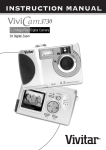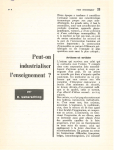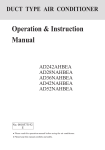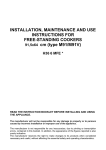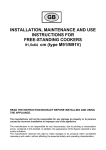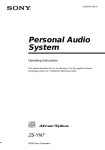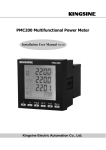Download Concord Camera 3103 Digital Camera User Manual
Transcript
INDEX Getting Started ............................................................................ 1 Contents of Package ........................................................................... 1 System Requirements ......................................................................... 1 General Precautions ............................................................................ 2 FCC Compliance and Advisory ............................................................ 2 Camera Nomenclature ......................................................................... 3 Accessory Set-up ................................................................................ 4 Preparing to Take Pictures ......................................................... 6 Battery Installation................................................................................ 6 Turning Camera ON and OFF .............................................................. 8 Date and Time Set-Up ......................................................................... 9 Beep Sound Set-Up .......................................................................... 11 Power Save Settings ......................................................................... 12 Quick View Setting ............................................................................. 13 TV Out Signal Set-Up ........................................................................ 14 Language Set-Up ............................................................................... 15 Using a Memory Card ........................................................................ 17 Camera Working Mode ...................................................................... 18 Taking Pictures ......................................................................... 19 Previewing a Picture before it is taken ............................................... 19 Taking a picture .................................................................................. 20 Adjusting the Exposure ..................................................................... 22 Setting the White Balance ................................................................. 23 Changing the Picture Resolution and Quality (Compression) ........... 24 Setting the Flash ................................................................................ 25 Using Digital Zoom ............................................................................ 26 Continuous Shutter Mode .................................................................. 27 Setting the Self-Timer........................................................................ 28 Recording Video images ................................................................... 29 Functions Available in Each Shooting Mode...................................... 30 Reviewing Your Pictures and Videos ....................................... 31 Viewing Pictures ................................................................................ 31 Viewing Thumbnail Pictures............................................................... 31 Zooming the Displayed Image .......................................................... 32 Deleting Pictures ............................................................................... 33 Protecting Pictures against Deletion ................................................. 35 Running a Slide Show ........................................................................ 37 Copying Flash Memory Images to a Memory Card ........................... 38 Formatting the Memory Card or Internal memory ............................. 39 Setting Your Camera for Printing ............................................. 40 Folders and Files ............................................................................... 40 DPOF Print Settings .......................................................................... 41 PRINT Image Matching ..................................................................... 43 Installing the Driver & Software............................................... 44 Installing the Driver........................................................................... 44 Installing the Software...................................................................... 45 Using MGI PhotoSuite 4 SE ............................................................. 47 Connecting your Camera ......................................................... 48 Viewing Images on a TV Set............................................................. 48 Downloading Images to a Computer.............................................. 48 About the memory storage you are using in this camera............ 51 Indicator Lamp Reference ................................................................. 52 Troubleshooting ................................................................................. 53 Specifications .................................................................................... 55 Getting Started Getting Started Contents of Package All of the items shown below are included with your camera. Camera Quick Start Guide USB cable Video cable Strap User's Guide CD-ROM Alkaline batteries (2 AA-size batteries) System Requirements For Windows PC with processor better than MMX Pentium 166MHz Windows 98/98SE/2000/ME/XP Minimum 32MB RAM USB Port CD-ROM drive For Macintosh Mac Power PC or higher Mac OS 9.0 - 10.0 Minimum 32MB RAM USB Port CD-ROM drive 800x600 pixels, 16-bit color display compatible monitor * Specifications are subject to change without prior notice. 1 Pouch Getting Started General Precautions · · · · · Do not try to open the case of the camera or attempt to modify this camera in any way. High-voltage internal components create the risk of electric shock when exposed. The maintenance and repairs should be carried out by authorized service providers. Do not fire the flash near eyes, human or animal. It may cause eye damage especially for children. Do not use this camera with wet hands. Keep the camera away from water and other liquids. Moisture creates the danger of fire and electric shock. Never use this camera in the rain or snow. For safety reasons, please keep this camera and accessories out of reach of children or animals to prevent accidents. If you notice smoke or a strange odor coming out of the camera, immediately turn the power off and unplug the AC adaptor from the power outlet. Take it to your nearest service center for repair. Never attempt your own maintenance. FCC Compliance and Advisory This device complies with Part 15 of the FCC Rules. Operation is subject to the following two conditions: 1.) this device may not cause harmful interference, and 2.) this device must accept any interference received, including interference that may cause undesired operation. This equipment has been tested and found to comply with the limits for a Class B peripheral, pursuant to Part 15 of the FCC Rules. These limits are designed to provide reasonable protection against harmful interference in a residential installation. This equipment generates, uses and can radiate radio frequency energy and, if not installed and used in accordance with the instructions, may cause harmful interference to radio communication. However, there is no guarantee that interference will not occur in a particular installation. If this equipment does cause a harmful interference to radio or television reception, which can be determined by turning the equipment off and on, the user is encouraged to try to correct the interference by one or more of the following measures. · · Reorient or relocate the receiving antenna. Increase the separation between the equipment and receiver. · Connect the equipment into an outlet to a circuit different from that to which the receiver is connected. · Consult the dealer or an experienced radio/TV technician for help. 2 Getting Started Any changes or modifications not expressly approved by the party responsible for compliance could void the user’s authority to operate the equipment. Where shielded interface cables have been provided with the product or specified additional components or accessories elsewhere defined to be used with the installation of the product, they must be used in order to ensure compliance with FCC regulation. Camera Nomenclature Front Exposure sensor Viewfinder Flash Microphone Lens Self-timer lamp Back Mode dial button Shutter button LED indicator Viewfinder Power button Speaker / Zoom In / Up button / Self-timer / Left button / Continuous shutter / Right button / Zoom Out / Down button LCD Monitor screen Battery cover / / Flash / / Play / / Pause button / /Stop button 3 Getting Started Side DC IN terminal Video out terminal USB port Top Shutter button Mode dial Accessory Set-up Attaching the Wrist Strap · Follow the illustration to attach the wrist strap. Note: When carrying the camera by the strap, please don’t swing the camera on the strap. 4 Getting Started Using the Soft Case · · Keep the camera in its soft case while it is not in use. Be sure to insert the camera into the case, with the monitor screen facing down. 5 Preparing to Take Pictures Preparing to Take Pictures Battery Installation There are two ways to supply power to the camera. You can use batteries (AA Alkaline or CR-V3), or alternatively, you can use an AC adapter (DC3.3V/2.5A). If using Batteries, 1. Open the battery cover by pushing and sliding it to the side. 2. Check inscription on battery chamber for correct negative/ positive installation. 3. Install 2-AA alkaline batteries. 6 Preparing to Take Pictures 4. Close the battery cover. Low Battery Indicator Upon power up, the LCD monitor on the back of the camera shows the battery power status. Battery Capacity Monitor Screen High Low NOTE: · Never use manganese batteries, as they cannot supply sufficient power to support the camera’s · operations. Replace all the batteries at the same time to ensure a properly working camera; never mix old and new · batteries. Remove the batteries from the camera if you do not plan on using the camera for more than two weeks. · It is normal that the temperature of the camera body · rises after extended use. It is suggested to use an AC adaptor for extended camera use. 7 Preparing to Take Pictures If using the AC Adaptor Plug the adaptor into the DC-In jack (DC-IN 3.3V). Please make sure that you use an AC adaptor with the correct specification for the camera (DC3.3V/2.5A). NOTE: · Please be sure to turn off the power before connecting or disconnecting the adaptor. · The camera automatically switches over to AC adaptor powered operation whenever the AC adaptor is plugged into the camera. · It is recommend to use the AC adaptor to power the camera whenever connected to a computer. Turning the Camera ON and OFF 1. Turn the Mode dial to Auto mode ( ). 2. Press the Power button to turn the camera on and off. NOTE: · It takes about 2 seconds to power on the camera. · When powering on the camera while in the Auto/Manual/Video mode, the date and time will be displayed on the lower right hand corner of the LCD screen for one second each. 8 Preparing to Take Pictures Date and Time Set-Up 1. You may set the date and time while in any mode. ) ( 2. Press the MENU button. 3. Press the RIGHT button ( ( ) appears. 9 ) until the SETUP MENU Preparing to Take Pictures 4. Press the SET button to adjust the DATE & TIME. 5. Press the UP/DOWN ( date or time. / ) buttons to change the 6. Press the Set button to confirm your selection and move to the next date or time value. Use UP/DOWN button to change the display of date. A. YY/MM/DD B. MM/DD/YY C. DD/MM/YY 10 Preparing to Take Pictures Beep Sound Set-Up You may turn on/off the beep sound while in any mode. ) ( 1. Press the MENU button. 2. Press the RIGHT button ( ( ) until the SETUP MENU ) appears. 3. Press the DOWN button ( ) to scroll to BEEP. 4. Press the SET button to enter the BEEP menu. 5. Press the UP/DOWN ( / ) buttons to set the beep sound. 6. Press the SET button to confirm your setting. Note: The default setting is “On”. 11 Preparing to Take Pictures Power Save Settings You may perform power save settings while in any Mode. ) ( 1. Press the Menu button. 2. Then press the RIGHT button until the SETUP MENU ( ) appears. 3. Press the DOWN button ( ) to POWER SAVE. 4. Press the SET button to enter the POWER SAVE menu. 5. Press the UP/DOWN buttons to adjust the setting. 6. Press SET again to confirm your setting. Note: The default setting is “1 minute”. 1 minute: The LCD screen on this camera will automatically turn off if there is no activity for one minute. Pressing any button will illuminate the LCD. 12 Preparing to Take Pictures Note: If the camera is inactive for an additional minute, the camera will automatically power off. Press the POWER button to turn the camera back on. 3 minutes: The LCD screen on this camera will automatically turn off if there is no activity for three minutes. Pressing any button will illuminate the LCD. Note: If the camera is inactive for an additional minute, the camera will automatically power off. Press the POWER button to turn the camera back on. Off: This camera will not perform the power saving function. Quick View Setting You can view the picture immediately on the LCD screen right after it is taken. The Quick View Setting is available in all Modes. ) ( 1. Press the MENU button. 2. Then press the RIGHT button ( ) until the SETUP MENU appears. 3. Press the DOWN button ( menu. 13 ) to reach the QUICK VIEW Preparing to Take Pictures 4. Press the SET button to enter the QUICK VIEW menu. 5. Use the UP/DOWN button ( / ) to toggle between ON/OFF. 6. Press SET to confirm your selection. TV Out Signal Set-Up This camera can connect directly to a TV set. Please refer to “Viewing images on a TV set” on Page 44. It allows you to use the TV screen as your camera's LCD screen when shooting or replaying images. The Video output signal can be switched to NTSC or PAL to accommodate different signal systems. The default setting will vary between regions. NTSC: U.S.A., Canada, Taiwan, Japan, etc. PAL:: Europe, Asia (excluding Taiwan), etc. 1. Press the MENU button. 2. Press the RIGHT button ( appears. 14 ) until the SETUP MENU Preparing to Take Pictures 3. Press the DOWN button ( ) to TV Out. 4. Press the SET button to enter the TV Out selection. 5. Use the UP/DOWN buttons ( / ) to toggle between NTSC and PAL. 6. Press SET to confirm your selection. Language Set-Up Use this feature to select the language for the LCD screen. You may perform the language setting in any Mode. ( ) 1. Press the MENU button. 2. Press the RIGHT button ( MENU appears. 15 ) until the SETUP Preparing to Take Pictures ) to reach the LANGUAGE 3. Press the DOWN button ( menu.. 4. Press the SET button to enter the LANGUAGE selection. 5. Use the UP/DOWN ( / among the different options. 6. Press SET to confirm your selection. 16 ) buttons to toggle Preparing to Take Pictures Using a Memory Card Inserting a SD memory card 1. Slide the battery cover following the arrow direction on the cover (please refer to page 6). 2. The card slot is located next to the battery area. 3. Insert the SD card into the slot in the direction shown in the illustration. Note: SD cards are sold separately and can be purchased at most computer or electronic stores. Removing the SD memory card 1. Press the memory card into the camera and then quickly release it. The card will partially exit from the slot. 2. Pull the memory card out of the slot. 3. Close the battery/card cover (please refer to page 7). 17 Preparing to Take Pictures Camera Working Mode You can select the camera’s working mode by using the Mode dial located on the top of the camera. There are 4 working modes in this camera. Align point Auto Photo Mode ( ) In this mode, the camera will automatically set the exposure and white balance according to your shooting environment. Manual Photo Mode ( ) You can manually set the exposure and white balance before shooting. Playback Mode ( ) Replay or delete images from the camera. Download and display images on your computer. Video Mode ( ) Use this mode to record movies. You can also manually set the exposure and white balance before recording the video. 18 Taking Pictures Taking Pictures Previewing a Picture before it is taken You can preview the image on the LCD screen before you take it. 1. Set the Mode dial to Auto ( ) or Manual ( 2. Press the POWER button ( ). ) to power on the camera. While the camera is powering on, the LED indicator next to the Viewfinder will flash in red. When the LED turns green, the camera is ready for use. 3. The live image will automatically show on the LCD screen. Turn off the previewing LCD screen The LCD screen will come on while in any Mode. You can turn on/off the LCD screen by pressing the DISP button ( ). Turning off the LCD will also help to save battery power. 1. Press the DISP button ( ) one time to turn off the information display. 2. Press the DISP button ( ) twice to turn off the LCD screen. (Auto mode) (Turn off the information) 19 Taking Pictures Taking a picture There are two Modes you can choose from to take a picture. In the Auto Mode, just press the shutter button and let the camera judge the environmental conditions for you. In the Manual Mode, you can manually adjust the exposure and set the white balance based on different environmental conditions. If you don’t insert the SD card into the camera, you can take the pictures and store them in the camera's internal memory. If you insert the SD card into the camera, pictures will be saved to the SD card only. You can't access the SD card and the internal memory at the same time. Taking a Picture in Auto Mode 1. Turn the Mode dial to Auto ( 2. Press the POWER button ( ). ) to power on the camera. 3. Press the Shutter button halfway and align the auto focus mark on the subject you want to take. When the focus is locked, the auto focus mark turns green. 4. Take a picture by pressing the shutter button further. When the camera beeps, the image has been captured and will be recorded on the card or in the internal memory. * The camera will not emit a beeping sound if this function is disabled. 5. During recording to the memory card, the LED indicator will flash in Green. Once the LED indicator stops flashing, the recording has finished. 20 Taking Pictures Displays the number of additional images that can be recorded in the camera's internal memory. Displays the number of additional images that can be recorded on the SD card. NOTE: If an SD card is inside the camera while taking a picture, the number of additional images that can be recorded will be for the SD card only. Remove the SD card to take and save pictures in the internal memory. Taking a Picture in Manual Mode 1. Turn the Mode dial to Manual ( 2. Press the POWER button ( ). ) to power on the camera. 3. The shooting procedures are the same as “Taking a picture in Auto Mode”. NOTE: · While pressing the shutter button halfway down, a “camera shaking” icon may appear under the auto focus mark. This indicates that the camera is not being held securely or the subject is not in focus. · While pressing the shutter button halfway down, you can also check if there is proper exposure value. · If the display indicators on the LCD screen turn green, this · means the camera has automatically locked the exposure and white balance for you. If the display indicators on LCD screen turn red, this means the camera’s auto exposure and auto white balance function is not ready or the conditions are not ideal for optimal quality picture taking. If you take the picture despite the conditions, the picture may be over or under exposed. 21 Taking Pictures Adjusting the Exposure You can manually set the exposure value (EV value ) to compensate for lighting conditions. This setting is used to obtain better results when shooting in backlighting, indirect indoor lighting or a dark background. ). 1. Turn the Mode dial to Manual ( 2. Press the MENU button. 3. Use the UP/DOWN button ( / ) to set the exposure value. 4. Press the SET button to complete the exposure setting. · · EV Value Range: Steps: -2EV to +2EV 1/3V NOTE: Exposure compensation returns to its standard default setting (AUTO) every time you turn on the camera. 5. After you manually set the exposure value in “Manual” mode, the exposure value will be shown in the LCD screen. 22 Taking Pictures 6. Press the menu button to exit from the exposure setting menu. Setting the White Balance You can set the white balance mode to match different light sources. 1. Turn the Mode dial to Manual ( ). 2. Press MENU and use the LEFT/RIGHT buttons to scroll to WHITE BALANCE ( ). 3. Use the UP/DOWN button to set the white balance mode. 4. Press the SET button to confirm your selection. If the LCD screen is on, you can check the result by viewing the image on the LCD screen. · AUTO - Normal conditions (camera adjusts white balance automatically) · DAYLIGHT - Outdoor daylight · SHADE - Shade · TUNGSTEN - Indoors, illuminated by tungsten lighting · FLUORESCENT - Indoors, illuminated by fluorescent lighting · BLACK&WHITE - converts images to black and white 23 Taking Pictures Changing the Picture Resolution and Quality (Compression) You can change the resolution and quality setting of images you will record. Resolution Setting: 1. Turn the Mode dial to Auto or Manual. 2. Press the MENU button. 3. Use the UP/DOWN button to set the resolution. 4. Press the SET button to confirm your selection. Quality Setting: 1. Turn the Mode dial to Auto or Manual. 2. Press the MENU button. 3. Use the RIGHT button to toggle to QUALITY( ). 4. Use the UP/DOWN button to set the quality of image compression. 5. Press the SET button to confirm your selection. After setting the resolution and quality, the following information icons will appear on the LCD screen. 24 Taking Pictures Display Resolution Icon 2048 x 1536 (Large) 1600 x 1200 (Medium-1) 1024 x 768 (Medium-2) 640 x 480 (Small) Display Quality Icon Fine Normal Economy Setting the Flash Press the button to select the flash mode. Auto The flash fires automatically when needed. The camera determines when there is not enough light. Red-Eye Reduction A pre-flash will fire automatically when needed before the picture is taken, and the Red-Eye Reduction lamp fires again when the picture is taken. Off The flash will not fire. Fill The flash fires every time you take a picture. 25 Taking Pictures Mode Auto Manual Video X X X X : Available X : Not Available Using Digital Zoom When the LCD screen is on in Auto or Manual Mode, you can zoom in on the subject before the image is taken. 1. Set the Mode dial to Auto ( ) or Manual ( ). 2. Turn on the LCD screen and the Information display (if not, press DISP button). 3. Press the UP button ( 4. Press the Down button ( ) to zoom in on the subject. ) to zoom out. (Auto mode) Zoom x1.0 26 Taking Pictures (Auto mode) Zoom In x1.8 Continuous Shutter Mode The camera will record images continuously at a speed of approximately 3 images every 2 seconds. 1. Turn the Mode dial to Auto ( ) or Manual ( 2. Press the Continuous Mode button( 3. Be sure that the ( ). ) . ) appears on the LCD monitor, then press the shutter button. To cancel the Continuous Mode function Press the Continuous Mode button ( 27 ) again. Taking Pictures Setting the Self-Timer When you use the self-timer function, the subject is recorded 2 or 10 seconds after pressing the shutter button depending on the setting option you select. 1. Turn the Mode dial to Auto ( ) or Manual ( 2. Press the Self-Timer button ( ) to choose the setting. ). The icons will appear on the right hand side of the LCD. Self-Timer Options: OFF - Turns self-timer off (no icon appears). - 2 SEC.(Press Self-Timer one time) Indicates a countdown of two seconds. - 10 SEC. Indicates a countdown of ten seconds. 3. Be sure that the (2 sec.) or (10 sec.) icon appears on the LCD monitor, then press Shutter button. 4. The Self-Timer lamp will flash in red when you press shutter button. NOTE: The self-timer feature is automatically disabled after use. To use this feature for another picture, please follow the steps above. NOTE: The self-timer feature cannot be used in conjunction with the continuous shutter mode. 28 Taking Pictures Recording Video images You can record video clips with audio. 1. Turn the Mode dial to Video ( ). 2. Press and release the shutter button to start video recording. Recording length (Sec.) This red spot flashes while recording. 3. Press the shutter button again to stop recording. * The following message will appear when the memory becomes full: MEMORY FULL, DELETE UNNEEDED IMAGE". Adjusting the exposure and white balance before recording Please refer to page 20. NOTE: · · In Video mode, the resolution is set to 320x240 pixels. There are no zoom functions in Video Recording Mode. · · Be careful not to touch the microphone while recording. The maximum length of individual video recording will depend on the memory space. The recording will end automatically when the storage memory becomes full. 29 Taking Pictures Functions Available in Each Shooting Mode Function Mode EXPOSURE Exposure Compensation Valve: -2.0 ~ +2.0 WHITE BALANCE RESOLUTION QUALITY Auto Manual Video X AUTO X DAYLIGHT X SHADE X TUNGSTEN X FLUORESCENT X BLACK&WHITE X 2048 X 1536 X 1600 X 1200 X 1024 X 768 X 640 X 480 X FINE X NORMAL X ECONOMY X DATE&TIME BEEP SET UP POWER SAVE QUICK VIEW TV OUT LANGUAGE FORMAT Flash Auto X Red-Eye Reduction X Off X Fill X Continuous Shutting Self-Timer X X Digital Zoom X : Available X : Not Available 30 Reviewing Your Pictures and Videos Reviewing Your Pictures and Videos Viewing Pictures You can view pictures and images in Playback mode. ). The LCD screen displays 1. Turn the Mode dial to Playback ( the last recorded image. Images being reviewed were recorded in the camera's internal memory. Images being reviewed were recorded on the SD card. NOTE: If an SD card is inside the camera while in Playback Mode, only the pictures on the SD card will be displayed. Remove the SD card to review pictures in the internal memory. 2. Use the RIGHT/LEFT button ( ) to view different pictures. / NOTE: ). · To view video clips, press the PLAY button( · Press the STOP button ( · If you press STOP while the video is playing, the video will return to the first image. ) to stop the video. Viewing Thumbnail Pictures You can view up to 9 images at a time by using the THUMBNAIL function ( 1. Turn the Mode dial to Playback mode ( ). 2. The LCD screen displays the last recorded image. 3. Press button twice to enter thumbnail mode. 31 ). Reviewing Your Pictures and Videos Zooming the Displayed Image When viewing a single image in Playback Mode, you can magnify the image you selected. The scale of magnification is x1.0 ~ x4.0. 1. Turn the Mode dial to Playback mode. 2. Magnify the image to the desired scale of magnification by using the UP button ( ). 3. Press the DOWN button ( ) to zoom back to the original full sized image. If an image is magnified, the ratio indicator will be displayed on the left hand side of the LCD. View different areas of the magnified image. 1. Press the SET button. The four-way arrow directors will appear on the LCD screen. 2. Press the UP/DOWN/LEFT/RIGHT buttons to view different areas of the image. 3. Press the SET button again to return to the magnify function. 32 Reviewing Your Pictures and Videos Deleting Pictures You can delete a single or all images while in Playback mode( ). Deleting a Single Image 1. Turn the Mode dial to Playback mode( ). 2. Press the MENU button. Use the UP/DOWN buttons to toggle between SINGLE and ALL. 3. Press the SET button to make your selection. 4. Use the UP/DOWN button to highlight the icon and return to the menu and not delete the image. Press SET to return to the “DELETE MENU”. Press the down button to highlight the delete icon ( 5. Press the SET button to confirm your selection. Deleting All Unprotected Images 1. Turn the Mode dial to Playback mode( 33 ). ). Reviewing Your Pictures and Videos 2. Press MENU button. 3. Press the UP/DOWN button to toggle between the options. 4. Press the SET button. Use the UP/DOWN buttons to toggle between CANCEL and YES. 5. Press the SET button to confirm your selection. 34 Reviewing Your Pictures and Videos Protecting Pictures against Deletion Protect or unprotect a single image 1. Turn the Mode dial to Playback mode ( ). 2. Scroll to the picture you would like to protect. 3. Press the MENU button and use the RIGHT button ( ) to toggle to the PROTECT function. 4. Highlight SINGLE and press the SET button. 5. Press SET button again to confirm your selection. 6. To unprotect the image, press the SET button again. NOTE: 1. Be sure that the PROTECT icon ( ) appears after your setting. 2. Use the LEFT/RIGHT button to scroll to the next image. 35 Reviewing Your Pictures and Videos Protect or unprotect all images 1. Follow procedure 1, 2, and 3 in ‘Protect or unprotect a single image’. 2. Highlight ALL and press the SET button. 3. Press the UP/DOWN button to highlight ON or OFF. 4. Press the SET button to confirm your selection. 36 Reviewing Your Pictures and Videos Running a Slide Show View your pictures on the camera LCD screen by using the Slide Show feature. The pictures appear for a period of 5 or 10 seconds depending on the option you choose. 1. Turn the Mode dial to Playback mode ( 2. The last picture taken appears on the LCD screen. 3. Press the MENU button and use the RIGHT button to scroll to “SLIDE SHOW “ ( 4. ). ). Press the UP/DOWN button to choose the number of seconds you would like the pictures to appear on the LCD screen. Time-settings are as follows: OFF – The Slide Show feature default sets as OFF. 5 sec. – The pictures will appear on LCD screen for a period of 5 seconds. 10 sec. – The pictures will appear on LCD screen for a period of 10 seconds. 5. Press the SET button to confirm your selection and start to run the slide show. Note: 1. You may stop the slide show by pressing any button. 2. The slide show will continue to run as long as there is power supply. 3. For continued use, it is recommended that you use AC power. 37 Reviewing Your Pictures and Videos Copying Flash Memory Images to a Memory Card Copy all images currently in the camera’s internal memory to a memory card. 1. Turn the Mode dial to Playback mode ( ). 2. Press the MENU button 3. Press the RIGHT button to select to “COPY TO CARD”( ). 4. Use the UP/DOWN button to select NO or YES. 5. Press the SET button to confirm your selection. - This starts the copy operation. - After all the images are copied to the card, the message “COPY COMPLETE” appears on the camera LCD screen. Note: - When Copying images on to the SD card, the images you copy will not be deleted from the internal memory. - You cannot copy the images from the memory card to the camera's internal memory. 38 Reviewing Your Pictures and Videos Formatting the Memory Card or Internal Memory 1. Turn the Mode dial to Playback mode ( ). 2. Press the MENU button. 3. Press the RIGHT button to scroll to ìFORMATî( ). 4. Use UP/DOWN button to select NO or YES. 5. Press the SET button to confirm your selection. YES ñ Formats the memory. NO ñ Cancels formatting operation. - This starts the FORMATTING operation. - After the memory storage is formatted, the message ìNO IMAGEî appears on the camera LCD screen. Note: The data deleted by a format operation cannot be recovered. When performing the format operation with an SD card inserted in the camera, only the images on the SD card will be permanently lost. When performing the fromat operation without an SD card inserted in the camera, only images in the camera's internal memory will be permanently lost. 39 Setting Your Camera for Printing Setting Your Camera for Printing Folders and Files Your camera automatically creates a directory of folders in it's internal memory or on the memory card to store images. Folders A folder is created automatically whenever you shoot the first image on a particular date. The name assigned to the folder is based on the current date, as described below. Example: Folder created on Sep. 20, which is the 100th folder on the memory card. 100_0920 Day Month Under Line Serial Number Files Each folder can contain up to 9,999 image files. If you try to save the 10,000th picture to a folder, the camera automatically creates a new folder and stores the image in the new folder. The name assigned to the file is based on the current date, as described below. Example: 28th image taken on Nov. 20. 11200028.JPG Extension File Name Serial Number Day Month Note: The actual number of files you will be able to store on a memory card depends on the capacity of the card, and image quality settings. 40 Setting Your Camera for Printing DPOF Print Settings On your SD card, select which image or images you want to print and the number of copies. This is convenient for printing on printers with the DPOF function or at any print service. SD Card DPOF The letters “DPOF” stand for “ Digital Print Order Format,” which is a format for recording on a memory card or other medium. You can print on a DPOF-compatible printer or at a professional print service from the memory card in accordance with the file name and number of copies recorded on the cards. Print Order Setting 1. Turn the Mode dial to PLAY mode( ). 2. Use the RIGHT/LEFT button to select the image you want to print. 3. Press the Menu button. 41 Setting Your Camera for Printing 4. Press the RIGHT button to toggle to PRINT ORDER. 5. Select either SINGLE or ALL. Press the SET button to confirm your selection. DPOF Options: Copies - Specify the number of copies to be printed. DATE Use the UP/DOWN button to choose the numbers. - Insert a date stamp into the image. Use UP/DOWN button to choose ON/OFF. Press RIGHT button Press LEFT button Scroll forward to the next image. Scroll back to the previous image. Resetting the Print Order Setting The Reset feature clears all print selections and resets COPIES to “00” , and the DATE to “OFF”. 42 Setting Your Camera for Printing PRINT Image Matching This camera supports PRINT Image Matching. Images recorded with this feature include information about the mode setting, camera setup, etc. When you print an image on a printer that supports PRINT Image Matching, the printer reads this data and adjusts the printed image accordingly. See the documentation that came with your printer for full details about PRINT Image Matching. * PRINT Image Matching is a term for the print command that is embedded in the header file of the image created by the Digital Camera. It contains color setting and image parameter information. * SEIKO EPSON Corporation holds the copyright for PRINT Image Matching. 43 Installing the Software Installing the Driver & Software Note: You do not need to install the drivers if you are running Windows,ME, 2000 or XP. Please go to the "Installing the Software" section. Note to Mac users: You do not need to install drivers or software to transfer pictures. Please see "Downloading Images to a Computer" for instructions. Installing the Driver Installing Camera Drivers (Windows 98/98SE) If your operating system is Windows 98/98SE: 1. Insert the CD into your PC CD-ROM drive. Make sure that your camera is not connected to the computer. 2. A red check mark appears on the left side of each installaiton choice. Remove all checks except the one for the camera driver by clicking on the checks next to each choice. 3. Click on install. 4. Follow the on-screen instructions. After the installation has finished, reboot your computer. You are now ready to install the software. NOTE: If your system requires a manual installation: Click Run, type “(the CD-ROM drive):/install.exe”, then click OK. Follow the directions that follow to install all the software. 44 Installing the Software Installing the Software (Windows Users) You may choose to skip the software installation procedure if you already have photo editing software loaded on your computer or if you would like to transfer pictures without editing them. Please refer to the Downloading Images section for instructions on transferring pictures to you computer. If your operating system is Windows 98/98SE/2000/ME/XP: 1. Insert CD into your PC CD-ROM drive.Make sure that your camera is not connected to the computer. 2. Click on Photo Studio, Movie Studio, Video Conferencing and Panorama tools. A red check mark should appear in the circle next to each option. Camera Driver does not need to be checked. 3. Click on install. 1. Click the MGI PhotoSuite 4 SE menu on autorun frame. 2. A Welcome window will be displayed. Click [Next>] to move to the next step. 45 Installing the Software 3. The Software License Agreement window will be displayed. If you agree to this, click [YES], the window will then move to the next step. If you disagree, click [NO] and the install program will be canceled. 4. Click Next to continue the installation. 5. Select Destination Location. Click on Next 46 Installing the Software 6. We suggest creating a shortcut on your desktop by selecting this option. Click Next to continue the installation. 7. Click Next to continue the installation. 8. Start Copying Files window will displayed. Click [Next>] to start installation. 47 Installing the Software 9. Wait while the software is installed. 10. Click Finish to complete the the setup. 11. Click Continue. 48 Installing the Software 12.Click Cancel if you would like to complete the registration at a later date. If you would like to register now, complete the registration form and click Register. 13. Select "Yes, I will restart my computer". MGI Video Wave will install next. Follow the on screen instructions. After the installation has finished, choose YES when asked to restart. Photo Vista will install next. Follow the on screen instructions. After the installation has finished, choose YES when asked to restart. NOTE: If your system requires a manual installation: Click Run, type “(the CD-ROM drive):/install.exe”, then click OK. Using MGI PhotoSuite 4 SE 1. Click Start> Programs> MGI PhotoSuite 4> MGI PhotoSuite 4. 2. This will open the MGI PhotoSuite software to edit, crop and print your pictures. 49 Connecting Your Camera Connecting your camera Viewing Images on a TV Set Images displayed on the camera’s monitor screen can also be displayed on a television screen. 1. Use the video cable to connect the camera to the TV set as shown. 2. Adjust your television set so that you obtain video input. 3. Normal playback and recording functions are available. NOTE: The camera LCD screen turns off automatically during video output. Selecting the Video Output Signal Mode Your camera supports both NTSC (used in U.S., Japan, and other countries) and PAL (used in Europe and other areas) video output signal systems. Plese refer to Page 14 for instructions on how to change your Video output signal to the correct setting. Downloading Images to a Computer There are two ways to download images taken with the camera to a computer. - Connect the camera to a computer via the USB cable. - Directly from the SD card. 50 Connecting Your Camera After installing the supplied software, download images automatically by simply connecting the camera to a computer with the supplied USB cable. Downloading Images Directly from a SD card 1. Eject the SD card from the camera, and inset it into a SD card reader which is connected to the computer. If you are using a PC card reader, first insert the SD card into a PC card adapter, and then insert the PC card adapter into the computer’s PC card reader. 2. Double-click the icon of the drive with the SD card. 3. Copy images from the card into a folder of your choice on the hard disk. Connecting the Camera to a Computer via USB Cable (Windows Users) 1. Make sure that you install the software and driver that comes on the CD-ROM first. 2. Connect the supplied USB cable to the computer’s USB port. Please refer to your computer manual for information regarding the USB port location. 51 Connecting Your Camera 3. Turn on your camera. When the connection to the computer is complete, the LCD screen turns off. 52 Connecting Your Camera NOTE: · When you disconnect the USB cable while the camera is on, the camera will automatically turn off. · It’s recommended to power the camera from a household power outlet with an AC Adapter. · If you are running Windows 98, the first time the camera is connected to the PC a message will appear on your monitor “Unknown device”; The driver installation will finish. 4. Click on “My Computer” and a “Removable Disk” drive will be displayed. 5. Double-click the “ Removable Disk” and you will see a “DCIM” folder. 6. All the images stored in the camera are transferred to the “DCIM” folder. If an SD card is inside the camera, only the images on the card will be transfered. 7. You can save your pictures to any location on your hard drive. Use the MGI software to edit your photos. Transferring Images to a Mac 1. Set the camera to review mode. 2. Connect the supplied USB cable to the camera and the computer's USB port. Please refer to your computer manual for information regarding the USB port location. 3. Turn on the camera. 4. The INTERNAL icon will appear on your desktop and the iPhoto screen will pop up. You may use either iPhoto or the INTERNAL icon to acquire images. Using iPhoto: Click on Import to transfer pictures. Using the INTERNAL icon: 1. Click on the INTERNAL icon. 2. The DCIM folder will appear. All the images stored in the camera are transferred to this folder. Open the folder and double click to view the images. 53 Connecting Your Camera About the memory storage you are using in this camera Internal Memory This camera has internal memory. If you do not insert a SD card into the camera, all images taken will be stored in the camera's internal memory. If you insert a SD card into the camera, the images taken will be stored in the SD card. Memory Card Data Images recorded with this camera and other data are stored on the memory card using DCF (Design rule for Camera File system) protocol. DCF protocol is designed for image and other data exchange between digital cameras and other devices. DCF Protocol DCF Protocol defines the format for image file data and the directory structure for the memory card. Images taken by a DCF camera, can be viewed in other DCF cameras as well. 54 Reference Reference LED Indicator Reference Chart Status Camera is ready Error Message LED ALWAYS ON UNIT: 100ms ON OFF Green Red Strobe Charge (not ready) Orange 2 3 Power On Status Green 2 2 Capture (including burst, AVI) Green 2 3 Playback Picture Green 3 3 F/W Update (Test Mode) Self-timer 2 3 Erase All (Test Mode) Green 2 3 Delete Single Green 2 3 Protect All Green 2 3 Slide Show (Read Image) Green 3 3 When AE is locked & strobe is ready, if strobe in Fill, Auto and Red-Eye Reduction mode. Orange Self-time capture 10 sec. 1~6 sec. Self-timer 5 5 7~8 sec. Self-timer 2 2 9~10 sec. Self-timer 1 1 Self-time capture 2 sec. Self-timer 1 1 Power Saving Green 10 10 O : Available X : Not Available 55 Video Playback Auto Manual USB Reference Message UNIT: 100ms LED ON OFF Door Open Red 2 2 Battery Empty Red 2 3 Busy (into thumbnail, delete all...) Green 3 3 Formatting Green 3 3 No Card Red 2 3 Copying Green 3 3 Copy Error Red 2 3 Not Enough Memory in Card Red 2 3 Protect (When do "delete single" to a protected file) Red 2 3 Protect All (When do "delete all" to all protected file) Red 2 3 No Image (delete single, delete all into, delete, protect, slide show, print order) when acting above actions, if no image desplayed, LED will light. Red 2 3 Copy to Card Troubleshooting Problem Power does not turn on. Cause Action - Reload batteries in the correct - Batteries are loaded in wrong direction. dirction. - Replace the batteries. - Batteries are dead. - Make sure the battery cover is - The battery cover is open. closed securely. - Turn the mode dial to Auto mode, Manual mode or Video mode. - The model dial is set to - Wait until the flash charges. Playback mode. - Insert a new SD card. The camera does not take pictures. - The flash is charging. - Delete images you no longer - Memory is full. - The SD card is nor formatted need. - Format the card correctly. correctly. - The card may be defective. Insert a new card. 56 Reference Problem Image does not record when the shutter button is pressed. Cause - The mode dial is set to Playback mode. - Flash is charging. - Memory is full. Action - Turn the mode dial to Auto mode or Manual mode. - Wait until the flash finishes charging. - Delete images you no longer need. - The camera was moving when you took images. Images are blurry or unfocused. - The subject was out of focus range. - Hold the camera steady when shooting. - Be sure that there is at least 80cm between the camera lens and the subject. - Press the shutter button halfway and align the auto focus mark on the subject. When the focus is locked, the auto focus mark turns green. Further depress the shutter button to take the picture. Recorded images are not saved in memory Camera powers off before the save operation has completed. If the low-battery indicator appears on the camera LCD screen, replace batteries with a full set of new ones. Images are not displayed. A memory card with non-DCF images recorded with another camera is loaded in the camera. This camera can not display non-DCF images. The flash doesn't fire. The flash mode is set to Off. Set the flash to any other mode except Off. Image not showing on TV. - There is a problem with the camera-TV connection. - Incorrect video system setting. - Please use the attached video cable to connect the camera to the TV correctly. - Set the video system to the appropriate setting, NTSC or PAL for your TV Cannot transfer images after connecting to a computer with USB cable. - USB driver is not installed. - Camera is turned off. - Install the USB driver before you connect the camera to a PC. - Turn on the camera. 57 Reference Specifications Sensor 3.3 Mega Pixels CCD (effective number of pixels approx. Lens F 3.1 Built-In ViewFinder Optical ViewFinder Focus Auto Focus Focus Range 20cm~Infinity ISO/ASA Sensitivity Auto LCD Display 1.5” TFT panel with LED back light Still Image Resolution Large: 2048x1536, Medium 1:1600x1200, 3.1million) Medium 2:1024x768, Small: 640x480 Video Resolution 320x240 Still Image Quality Fine: 5X-compression rate Normal: 8X-compression rate Economy: 12X-compression rate Exposure Meter Multi-pattern TTL AE Exposure Control Auto Auto Exposure Range: -2EV to +2EV in 1/3 steps Shutter Control Mechanical Shutter Digital Zoom Preview Mode: ~X3 continuous 0.2X/step Playback Mode: ~X4 continuous, 0.1X/step Digital Zoom (Video mode) N/A Image File Format Still & Burst: EXIF 2.1 compatible format (JPEG Compression) DCF compatible. Support DPOF, PIM Still Capture Mode Single Mode, Burst Mode: 3 pictures per shot White Balance Auto/Manual (5 modes in manual selection: daylight/ shade/ tungsten/ fluorescent/ black & white) Burst 3 pictures/shot Picture Storage On-board flash memory: 16MB External: SD memory card Microphone Built-In Sound Feedback Speaker Communication Interface USB 1.1 Self-Timer 2 steps, 2/10 sec. with Beep sound Playback Mode Single/ 9 Thumbnail pictures Video & Audio Out Yes, NTSC/PAL Power Supply AAx2 (1.5V Alkaline, or 1.2V, NiCd and Ni-MH Rechargeable), CRV3 58 Reference DC Input: +3.3V DC adapter Dimension Camera body: 97.5x64.5x36 mm Weight Camera body without battery and card: 175g * Specifications are subject to change without prior notice. 59 Technical Support Hot Line: Toll Free In the USA & Canada 1-866-522-6372 Toll Free In Europe UK: 0800-169-6482 BELGIUM: 0800-787-57 FRANCE: 0800-917-599 GERMANY: 0800-1800-563 SPAIN: 900-973-195 ITALY: 800-781-883 All Other Countries - Toll 31-53-482-9779

































































